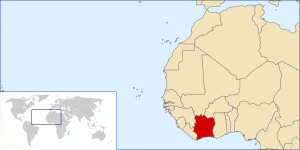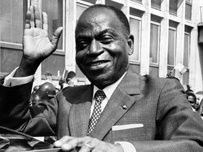 A little on Cote d’Ivoire’s history.
A little on Cote d’Ivoire’s history.
In the years preceding the arrival of Europeans the territory of Cote d’Ivoire consisted of an assembly of relatively small kingdoms, in the shade of the larger Ghana, Songhai and Mali empires to the north. Several ‘immigrant’ groups existed, like groups fleeing the Asante in neighbouring Gambia and Muslim people moving south from Mali empire. None of those achieved long term dominance, which made it not too difficult for the French to establish a foothold along the coast, firstly for a missionary post in Assinie. As elsewhere, initially interest was mostly commercial, not so much for trade in slaves, but more for ivory – what’s in a name? Only in the middle of the 19th Century did the French agree official treaties, first with coastal kingdom of Grand Bassam – thereafter the capital of the subsequent French colony – and later also further inland, despite continuing opposition from the largest local kingdom, the Baoule. Cote d’Ivoire differed from other colonies in that there was a significant presence of French settlers, who moved into the coffee, cocoa and palm oil business. The colony was incorporated in the Federation of French West Africa.
Despite the development of an indigenous educated elite, the French colonial system left little room for local participation in government. Yet, Félix Houphouët-Boigny, the son of a Baoulé chief, made it to the French parliament, and, upon independence in 1960, became the first president of Cote d’Ivoire, at the time easily France’s most prosperous West African territory.
And in the next twenty years the country showed the rest of Africa that it was, in fact, possible to be successful. Economic growth was around 10% per year, and Cote d’Ivoire became the largest cocoa producer in the world, and the third-largest coffee producer (behind Brazil and Columbia, fair enough). Until the economic crisis of the 1980s, when debt spiralled, poverty increased, as did crime in Abidjan. The lack of political plurality – a bit of an African leader wouldn’t allow more than one party, of course, and Houphouët-Boigny was not different – let to widespread street protest in the 1990s, but before anybody could grab power by military coup, Houphouët-Boigny died in 1993.
Houphouët-Boigny’s successor, Henri Konan Bédié, easily won the next election…and then proceeded to lock up all of the opposition. Which led to the inevitable coup d’etat. Followed by a presidential election won by Laurant Gbagbo, in 2000, among civil turmoil and protest. A rebel movement established itself in the north of the country, and a civil war ensued, with lots of senseless violence against civilians. French troops got involved, UN Peace keepers were mobilised, but not to the extent that elections could be held, so, yeah, Gbagbo for president forever.
Except that, finally, in 2010 elections were held again, Gbagbo lost against Alassane Ouattara. But he held on to power for another six months, once again triggering civil war, in which parts of the international community ultimately turned its military power against Gbagbo, who was finally arrested in April 2011. And, surprise, surprise, now Ouattara is still president, in his third term already, after elections collectively boycotted by all of the opposition.
Despite the political upheaval of the last 20 years, and the terrible toll it took on the country at the start of the 21st Century, Cote d’ Ivoire is still one of the better-off West African states, with a diversified economy. Various crops, foremost still coffee and cocoa, but also rubber and pineapples, and the production of offshore oil and gas help earn foreign reserves, although there is a sense that mostly townspeople benefit, whilst rural poverty is on the increase. We are going to see it, or at least, some of it.
Next: into Cote d’Ivoire










